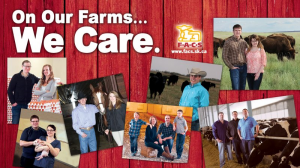It’s a good thing!
Jean L Clavelle
Today I would like to share some of the positive things I am enjoying about livestock agriculture! 
It is satisfying to hear about all of the young people going into agriculture as primary producers. Agriculture is not just a career choice with a myriad of job prospects but many young people are finding primary production a viable way of life. Going back to the farm offers a life that is inherently satisfying regardless of the stress and long hours. Each year the Farm Animal Council of Saskatchewan publishes a billboard campaign featuring influential and modern young farmers who are making significant strides in their fields. The 2014 campaign was recently released so if you are in Saskatchewan look for these signs around Saskatoon and Regina.
I am excited to see the increasing application of technology in the day to day operation on farm. Agriculture is not represented by the stereotype of uneducated hillbillies. I understand that this may not be what our consumer is expecting or perhaps, wants to see but I think it is reassuring. Many producers have a university education and are incorporating the latest technologies in their operations. This allows for production methods that are constantly improving - quicker identification of disease, better use of resources, healthier animals, and improved food supply for the consumer. This is meeting the challenge that society has set – to improve efficiency, sustainability and animal welfare. To me the use of cutting edge technology implies a need for improvement, for evolution and for advancement which is everything that agriculture should be doing.
A great example of this is dairy robotic milkers. As I have mentioned numerous times in previous posts I support many types of production systems - organic, conventional, small production for local markets, larger corporate farms etc etc etc. However for robotic milkers to be feasible, farms need to be large enough to warrant the expense of a robot and are thus a best fit in mid to large size operations. There are some advantages to robotic milkers that I believe warrant discussion. Cows have the option to choose to be milked at whatever frequency they desire, instead of being milked the conventional twice per day. It is interesting to see that cows will often go through the milker 2 to 5 times per day depending on the stage of lactation and the individual cow. Robots are able to measure the somatic cell count in the milk which is an indication of mastitis. Long before regular practices would be able to identify the problem the robot can predict disease and those cows treated as well as automatically divert the milk. This is beneficial for the cow and for the consumer and for the producer. Robotic systems also allow the producer to be in constant contact with their barn. Alarms will sound if there are ever any problems with the cows or equipment which prevents problems before it happens. Now this is not to say that non robotic systems cannot have optimal management but this technology certainly enhances a producers’ ability to manage his or her operation.
I think one of the biggest things I am enjoying right now is our renewed sense of pride in the fundamental nature of agriculture. T he AGvocate movement has re-ignited the belief that what we are doing is worthy and worth explaining to the world. Yes we need to continue to evolve and improve but overall Canadian agriculture efficiently and cleanly provides healthy food for our citizens. It may be overwhelming but the ag community has taken up the challenge to share what we do with society. And in the words of Martha Stewart “it’s a good thing”.
he AGvocate movement has re-ignited the belief that what we are doing is worthy and worth explaining to the world. Yes we need to continue to evolve and improve but overall Canadian agriculture efficiently and cleanly provides healthy food for our citizens. It may be overwhelming but the ag community has taken up the challenge to share what we do with society. And in the words of Martha Stewart “it’s a good thing”.
Posted by FACS on May 26th, 2014 :: Filed under Agricultural Advocates,Agriculture Education,AgVocacy,Animal welfare,Dairy cattle,Education and public awareness,Faces of Farming,Uncategorized
Tags :: agvocate, animal welfare, dairy cattle, robots
You can leave a response, or trackback from your own site.